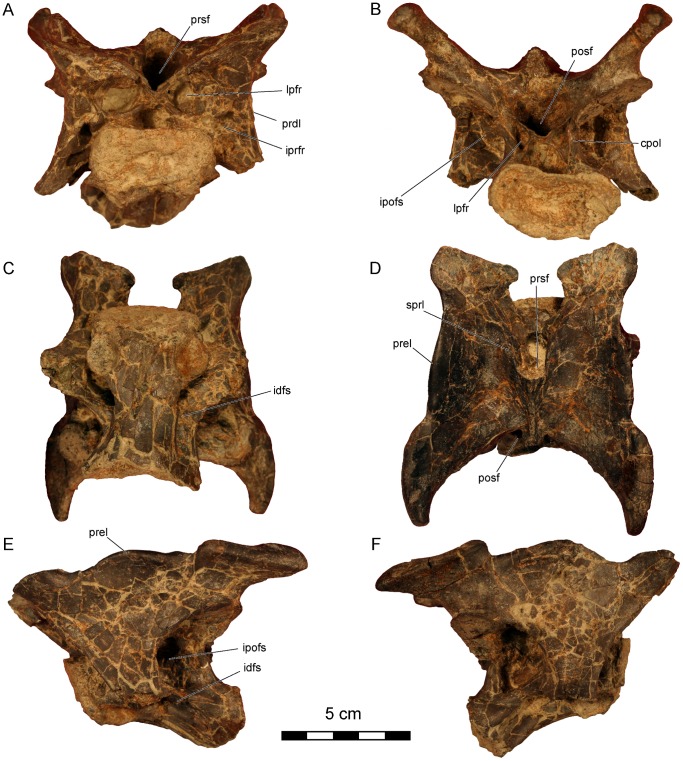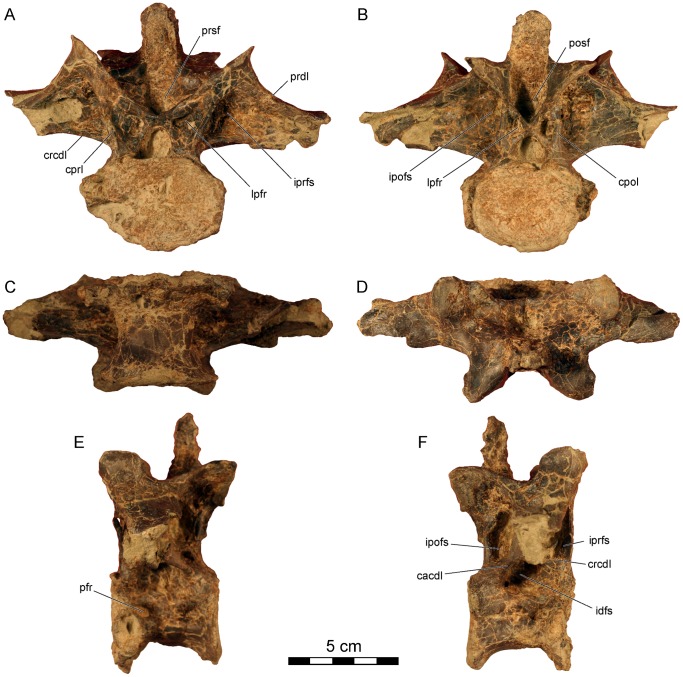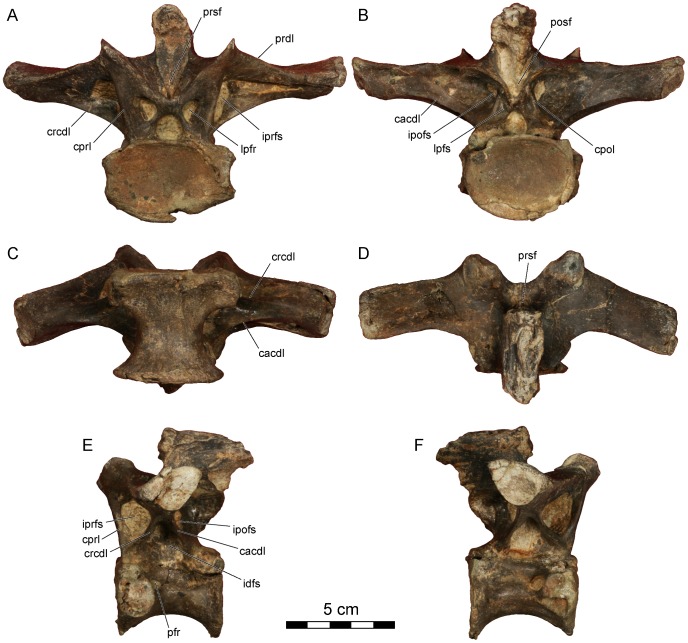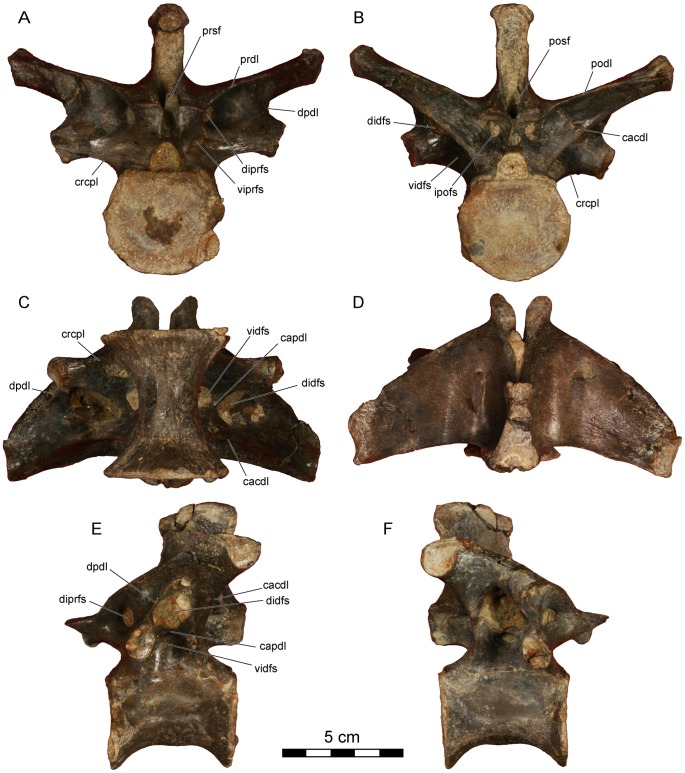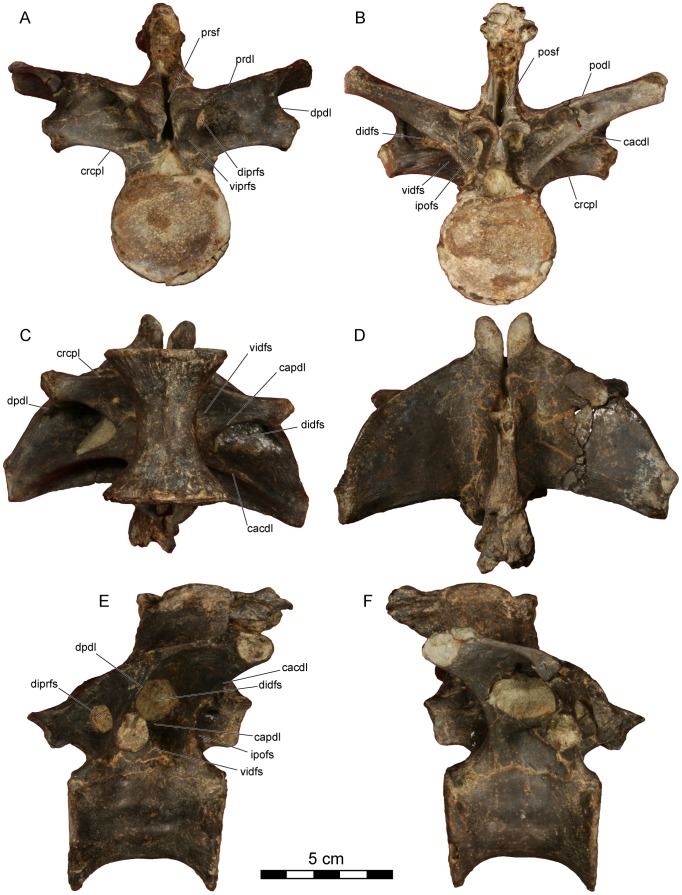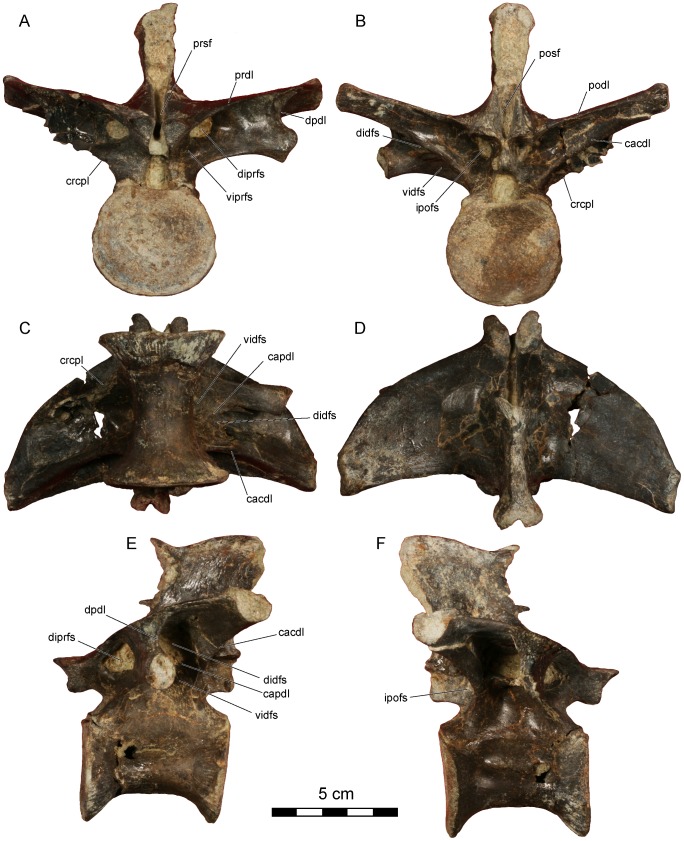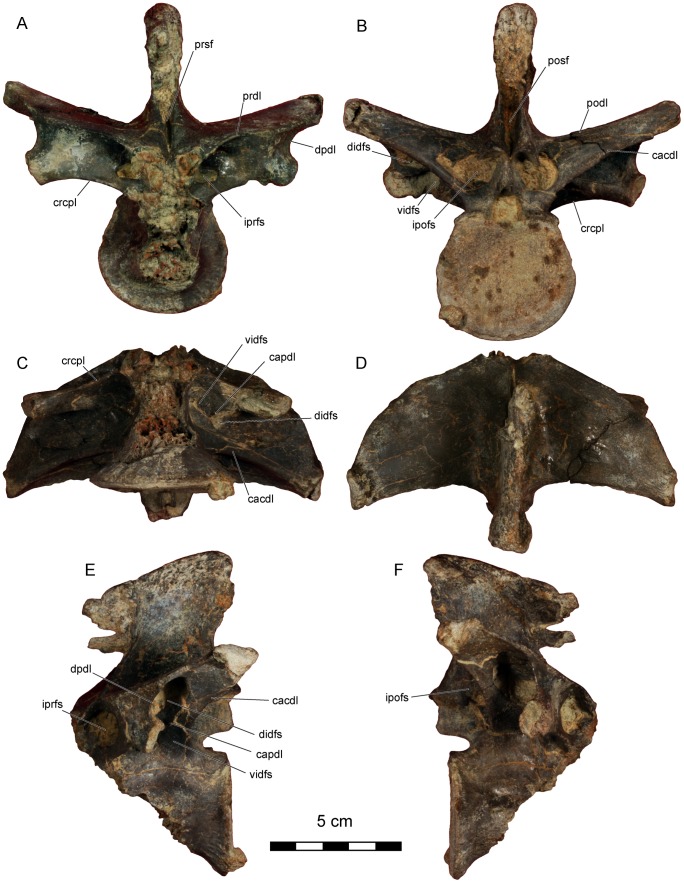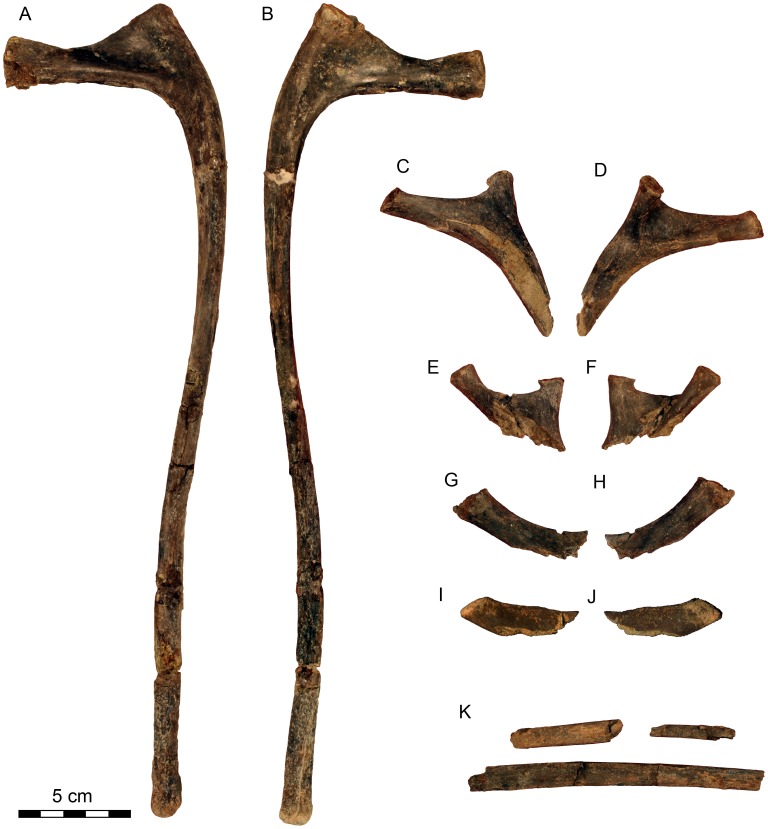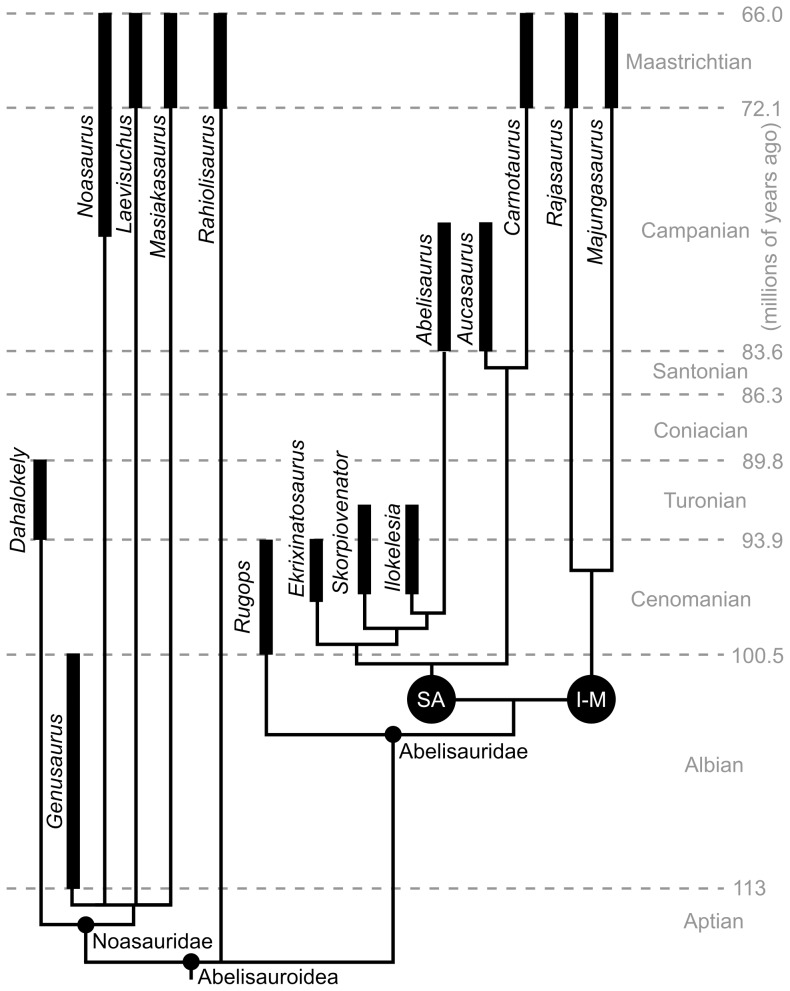Abstract
Geophysical evidence strongly supports the complete isolation of India and Madagascar (Indo-Madagascar) by ∼100 million years ago, though sparse terrestrial fossil records from these regions prior to ∼70 million years ago have limited insights into their biogeographic history during the Cretaceous. A new theropod dinosaur, Dahalokely tokana, from Turonian-aged (∼90 million years old) strata of northernmost Madagascar is represented by a partial axial column. Autapomorphies include a prominently convex prezygoepipophyseal lamina on cervical vertebrae and a divided infraprezygapophyseal fossa through the mid-dorsal region, among others. Phylogenetic analysis definitively recovers the species as an abelisauroid theropod and weakly as a noasaurid. Dahalokely is the only known dinosaur from the interval during which Indo-Madagascar likely existed as a distinct landmass, but more complete material is needed to evaluate whether or not it is more closely related to later abelisauroids of Indo-Madagascar or those known elsewhere in Gondwana.
Introduction
Since its separation from India and subsequent isolation ∼88 million years ago (Ma) [1], [2], Madagascar has hosted a highly endemic fauna and flora. The non-marine Cretaceous faunal assemblage of Madagascar is best represented by the Maastrichtian-aged (∼70 million years old) Maevarano Formation, with an exquisitely-preserved assemblage of non-avian dinosaurs (including titanosaurian sauropods and noasaurid, abelisaurid, and dromaeosaurid theropods), birds, crocodyliforms, turtles, fish, mammals and frogs [3]. Many of these Maevarano Formation vertebrates have been instrumental in the formulation of hypotheses concerning the Cretaceous biogeography of Madagascar. Some initial phylogenetic results for Maevarano Formation taxa suggested a close biogeographic relationship between South America and Madagascar, with organisms potentially dispersing via a late-surviving subaerial route that included Antarctica [4]–[7]. However, further consideration of geological and palaeontological evidence does not support this dispersal hypothesis. Instead, emerging evidence suggests complete isolation of the Indo-Madagascar landmass by 100 Ma, later followed by their separation from each other ∼88 Ma [8]–[10]. Reconstructed ghost lineages for major clades of obligate terrestrial vertebrates imply that the ancestors of the Maastrichtian fauna likely inhabited Indo-Madagascar by 100 Ma [10]. Nonetheless, confirmation of this has been greatly hampered by the paucity of pre-Maastrichtian terrestrial fossils from the Cretaceous of both the Indian subcontinent (for which only fragmentary Coniacian-aged, 89.8–86.3 Ma, and Cenomanian–Turonian, 100.5–89.8 Ma, dinosaurs are known [11]–[13]) and Madagascar (for which only isolated, undescribed elements are known from the uncertainly dated [Coniacian–?Santonian] Ankazamihaboka sandstone and nondiagnostic fragments from the Cenomanian, 100.5–93.9 million years old; [14], [15]).
Here we describe a new abelisauroid theropod, Dahalokely tokana, which at ∼90 Ma is the oldest identifiable dinosaur currently known from the Cretaceous of Madagascar and potentially predates the breakup of Indo-Madagascar. Abelisauroids are carnivorous theropod dinosaurs best-represented from Gondwana, originating in the mid-Jurassic at latest and persisting to the terminal Cretaceous [16], [17]. Two main clades are recognized: noasaurids are typically small-bodied (<3 m total body length) and at least some species had unusually procumbent teeth [18]; abelisaurids are larger bodied (>4 m total body length) and often characterized by greatly reduced forelimbs and cranial ornamentation [19]–[21]. Dahalokely tokana is a mid-sized taxon (∼3.5 m estimated body length) at least 20 million years older than the abelisaurid Majungasaurus crenatissimus and the noasaurid Masiakasaurus knopfleri from the Maevarano Formation of northwestern Madagascar. Thus, D. tokana pushes back the diagnostic record of abelisauroids on the island.
Methods
Nomenclatural acts
The electronic edition of this article conforms to the requirements of the amended International Code of Zoological Nomenclature, and hence the new names contained herein are available under that Code from the electronic edition of this article. This published work and the nomenclatural acts it contains have been registered in ZooBank, the online registration system for the ICZN. The ZooBank LSIDs (Life Science Identifiers) can be resolved and the associated information viewed through any standard web browser by appending the LSID to the prefix “http://zoobank.org/”. The LSID for this publication is: urn:lsid:zoobank.org:pub:AA81239E-D9E9-4C5F-BBC1-567EFF984DE0. The electronic edition of this work was published in a journal with an ISSN, and has been archived and is available from the following digital repositories: PubMed Central and LOCKSS.
Permits
All necessary permits were obtained for the described study, which complied with all relevant regulations. Fieldwork was conducted under permit from Ministère des Mines de Madagascar and in collaboration with the Ministère de l’Enseignement Supérieur et de la Recherche Scientifique de Madagascar.
Fieldwork and preparation
The specimen was discovered in situ in the field in northernmost Madagascar (Figure 1) during the 2007 field season. Fossils were manually excavated using standard paleontological techniques (hammer and chisel, etc.), stabilized in the field using Acrysol WS-24 colloidally dispersed in water, and encased in plaster field jackets. Preparation, including additional stabilization and removal of matrix from the specimens, was completed at the Stony Brook University Vertebrate Fossil Preparation Laboratory using steel and carbide picks, pneumatic tools, and paint brushes. Additional stabilization and repair in the lab required Paraloid B-72 acrylic co-polymer dissolved in acetone. Specimens were molded using a room-temperature vulcanizing tin-cured silicone rubber (Silicones, Inc. GI-1000) and cast with a pigmented and talced wax-free polyester resin. Mold parts were defined using plastalina modeling clay and also as crack and gap filler within specimens. Specimen surfaces and mold parts were sealed with Vinac B-15 dissolved in acetone, with subsequent polymer removed through acetone dilution and wicking of polymer and acetone onto lens paper. The specimen is accessioned into the permanent collection at the University of Antananarivo (UA; Antananarivo, Madagascar). Casts were deposited at the Raymond M. Alf Museum of Paleontology (RAM, Claremont, California, USA) under specimen number RAM 16010, and the molds archived at Stony Brook University Vertebrate Fossil Preparation Laboratory (Stony Brook, New York, USA). In order to visualize and evaluate field jacket contents prior to mechanical preparation, to examine internal structures, and for the purposes of producing a digital archive, selected elements were scanned using computed tomography (CT) at Stony Brook University Hospital (Stony Brook, New York, USA). Scan parameters varied depending upon the specimen. Resulting reconstructions of selected elements are in Figures S1, S2, S3, S4, and S5.
Figure 1. Map of the Dahalokely tokana holotype locality.
Schematic geological map of a portion of the Diego Basin in northern Madagascar, with outcrops of sedimentary rocks of medial and Late Cretaceous age shown in gray. The general locality for the holotype of Dahalokely tokana (UA 9855) is indicated by the area within the circle. The inset map shows the location of the region within Madagascar. Modified after Rerat [50], de Saint Ours and Rerat [51], and de Saint Ours et al. [52].
Measurements
Dimensions of the Dahalokely tokana holotype, UA 8678, were acquired to the nearest 0.1 mm using a digital calipers (Tables 1 and 2). Reference points and abbreviations follow those used by O’Connor ([22]:table 1) and are repeated here for ease of comparison.
Table 1. Selected measurements in millimeters of the vertebrae from the Dahalokely tokana holotype, UA 8678.
| Vertebra | CENL | CDCW | CDCH | MIDW | TOVH | NSH | NSL | NSW | IZW | IZL | IPPW | IDPW | PP/DP | EPL |
| C?5 | 64.5 | 41.5 | 23.8 | 32.3 | 74.2 | 30.7 | 25.3 | — | 75.3 | 81.6 | 42.4 | † | † | 20.8 |
| D?1 | 44.0 | 48.5 | 39.8 | 30.6 | 108.6 | 57.2 | 9.6 | 17.5 | 57.8 | 54.5 | 64.5 | † | † | — |
| D?2 | 48.7 | 50.4 | 38.4 | 30.0 | 97.0 | 50.6 | *21.1 | 16.0 | 50.9 | 56.9 | 60.1 | 158.4 | 0.379 | — |
| D?6 | 52.1 | 46.1 | 41.5 | 21.3 | 121.2 | 65.9 | 28.8 | 11.9 | 26.9 | 76.7 | 94.9 | 136.2 | 0.697 | — |
| D?7 | 55.1 | 46.9 | 42.3 | 22.2 | 116.1 | 62.7 | 34.5 | 11.9 | 27.0 | 83.3 | 101.8 | 126.1 | 0.807 | — |
| D?8 | 55.2 | 47.3 | 41.9 | 22.3 | 120.4 | 66.0 | 32.2 | 11.6 | 27.6 | 76.7 | 108.8 | 134.9 | 0.807 | — |
| D?9 | † | 52.9 | 45.4 | † | 126.7 | 69.9 | 33.7 | 10.9 | 24.0 | † | 105.6 | 129.7 | 0.814 | — |
Abbreviations (modified after [22]): CENL, maximum craniocaudal length of centrum; CDCW, maximum width of caudal articular facet of centrum; CDCH, maximum height of caudal articular facet of centrum; MIDW, width of centrum at mid-length; TOVH, total vertebral height at maximum dorsoventral extent including centrum and neural spine; NSH, maximum height of neural spine measured from dorsal surface of neural canal; NSL, craniocaudal length of neural spine at spine mid-height; NSW, transverse extent (width) of neural spine at spine mid-height; IZW, interzygapophyseal width, the distance between lateral margins of postzygapophyses; IZL, interzygapophyseal length, the distance from cranial margin of right prezygapophysis to caudal margin of right postzygapophysis; IPPW, interparapophyseal width, measured between lateral limits of parapophyses; IDPW, interdiapophyseal width, measured between lateral limits of diapophyses; PP/DP, Para-Diapophyseal Index, ratio of IPPW to IDPW; EPL, epipophyseal length, measured from caudal margin of postzygapophyseal facet to caudalmost extent of epipophysis. —, measurement not applicable for element; †, element incomplete for measurement. *excludes ossified interspinous ligament.
Table 2. Selected measurements in millimeters of the ribs from the Dahalokely tokana holotype, UA 8678.
| Rib | ML | CTL |
| DR?2 | 339.9 | 78.9 |
| DRcd | † | 58.8 |
Abbreviations: DR?2, dorsal rib ?2; Drcd, dorsal rib fragment figured in Figures 10C, 10D; ML, maximum length, from tuberculum to distal end of shaft; CTL, maximum distance between extreme ends of capitulum and tuberculum; †, element incomplete for measurement.
Geological Context
Age of the Dahalokely tokana holotype locality
Several studies have considered the age of the Upper Cretaceous section exposed in and around the area of Antsiranana using biostratigraphy [23]–[27]. Although the sediments that produced Dahalokely have not yet yielded fossils of biostratigraphic significance, these strata are bracketed by marine deposits containing biostratigraphically informative fossils.
The section containing the Dahalokely site is informally termed the “Ambolafotsy Formation,” and is divided into lower, middle (containing the type locality; Figure 1), and upper units [23]. The lower unit has produced several biostratigraphically informative foraminifera, including Whiteinella aprica, W. baltica, Helvetoglobotruncana praehelvetica, and H. helvetica, and the nannofossil Quadrum gartneri [23], [25], placing the sample within the Q. gartneri and H. helvetica zones [25]. Relevant biostratigraphic zones and ranges were sourced from Ogg and Lugowski [28], which draws upon data from other published resources (particularly references within [29]), recalibrated to the Geologic Time Scale 2012 [30]. Helvetoglobotruncana helvetica is the most informative of the foraminifera, defining a zone within the latter part of the early Turonian (∼93.52–92.99 Ma). The earliest occurrence of Q. gartneri is during the second half of the early Turonian (93.55 Ma), and it persisted into the late Coniacian (∼86.44 Ma). Thus, the co-occurrence of these two species suggests that the sediments of the lower unit were deposited during the latter part of the early Turonian (93.52–92.99 Ma). The upper unit contains the ammonite Subprionocyclus neptuni [23], [24], a taxon restricted to the late Turonian (90.86–89.77 Ma). Because no biostratigraphically informative microfossils are known from the middle unit yet, these terrestrial deposits may have overlapped temporally with some of the marine biozones. Even so, this biostratigraphic evidence restricts the age of the type locality for Dahalokely to the interval including the latter part of the early Turonian through the late Turonian (∼93.52–89.77 Ma).
Depositional environment of the Dahalokely tokana holotype locality
The sediments of most of the middle unit of the Ambolafotsy Formation are interpreted as terrestrial, deposited during a marine regression [23]. Carbonized plant fragments are quite common in the middle unit, along with claystones, shales, and cross-bedded sandstones. Marine microfossils and macrofossils are generally absent [23], [25], although a deposit of ostreids several meters above the type locality for Dahalokely suggests that the area was deposited close to the shoreline.
Systematic Paleontology
Theropoda Marsh 1881 [31] sensu Gauthier 1986 [32].
Abelisauroidea Bonaparte and Novas 1985 [33] sensu Bonaparte 1991 [34].
Dahalokely Farke and Sertich gen. nov.
urn:lsid:zoobank.org:act:8147803A-D4BE-4BA9-9701-D853E37DE411.
Dahalokely tokana Farke and Sertich sp. nov.
urn:lsid:zoobank.org:act:AFAE32BB-123A-45D4-B931-4FF2AABAF41C.
Holotype
UA 9855, a partial axial column including cervical vertebra C?5, dorsal vertebrae D?1, D?2, and D?6–D?9, as well as a complete left dorsal rib (DR?2), capitula of two right dorsal ribs, proximal ends of two dorsal ribs, and other rib fragments (Figures 2, 3, 4, 5, 6, 7, 8, 9, and 10, S2, S3, S4, and S5). The elements were disarticulated but closely associated in situ within 1 m of each other.
Figure 2. Dahalokely tokana, holotype (UA 9855).
A, reconstructed silhouette with preserved elements indicated in white. Cervical vertebra (C?5) in B, cranial; C, left lateral; and D, dorsal views. Dorsal vertebra (D?2) in E, cranial; F, left lateral, and G, dorsal views. Dorsal vertebra (D?6) in H, cranial; I, left lateral; and J, dorsal views. Abbreviations: cprl, centroprezygapophyseal lamina; didfs, dorsal infradiapophyseal fossa; diprfs, dorsal infraprezygapophyseal fossa; dp, diapophysis; ep, epipophysis; ha, hypantrum; ho, hyposphene; idfs, infradiapophyseal fossa; ipofs, infrapostzygapophyseal fossa; iprfr, infraprezygapophyseal foramen; iprfs, infraprezygapophyseal fossa; lpfr, laminopeduncular foramen; ns, neural spine; pfr, pneumatic foramen; posf, postspinal fossa; poz, postzygapophysis; pp, parapophysis; prel, prezygoepipophyseal lamina; prsf, prespinal fossa; prz, prezygapophysis; sprl, spinoprezygapophyseal lamina; vidfs, ventral infradiapophyseal fossa; viprfs, ventral infraprezygapophyseal fossa.
Figure 3. Dahalokely tokana holotype (UA 9855), ?fifth cervical (C?5) vertebra.
Photographs in A, cranial; B, caudal; C, ventral; D, dorsal; E, left lateral; and F, right lateral views. Abbreviations: cpol, centropostzygapophyseal lamina; idfs, infradiapophyseal fossa; ipofs, infrapostzygapophyseal fossa; iprfr, infraprezygapophyseal foramen; lpfr, laminopeduncular foramen; posf, postspinal fossa; prdl, prezygodiapophyseal lamina; prel, prezygoepipophyseal lamina; prsf, prespinal fossa; sprl, spinoprezygapophyseal lamina.
Figure 4. Dahalokely tokana holotype (UA 9855), ?first dorsal (D?1) vertebra.
Photographs in A, cranial; B, caudal; C, ventral; D, dorsal; E, left lateral; and F, right lateral views. Abbreviations: cacdl, caudal centrodiapophyseal lamina; cpol, centropostzygapophyseal lamina; cprl, centroprezygapophyseal lamina; crcdl, cranial centrodiapophyseal lamina; idfs, infradiapophyseal fossa; ipofs, infrapostzygapophyseal fossa; iprfs, infraprezygapophyseal fossa; lpfr, laminopeduncular foramen; pfr, pneumatic foramen; posf, postspinal fossa; prdl, prezygodiapophyseal lamina; prsf, prespinal fossa.
Figure 5. Dahalokely tokana holotype (UA 9855), ?second dorsal (D?2) vertebra.
Photographs in A, cranial; B, caudal; C, ventral; D, dorsal; E, left lateral; and F, right lateral views. Abbreviations: cacdl, caudal centrodiapophyseal lamina; cpol, centropostzygapophyseal lamina; cprl, centroprezygapophyseal lamina; crcdl, cranial centrodiapophyseal lamina; idfs, infradiapophyseal fossa; ipofs, infrapostzygapophyseal fossa; iprfs, infraprezygapophyseal fossa; lpfr, laminopeduncular foramen; lpfs, laminopeduncular fossa; pfr, pneumatic foramen; posf, postspinal fossa; prdl, prezygodiapophyseal lamina; prsf, prespinal fossa.
Figure 6. Dahalokely tokana holotype (UA 9855), ?sixth dorsal (D?6) vertebra.
Photographs in A, cranial; B, caudal; C, ventral; D, dorsal; E, left lateral; and F, right lateral views. Abbreviations: cacdl, caudal centrodiapophyseal lamina; capdl, caudal paradiapophyseal lamina; crcpl, cranial centroparapophyseal lamina; didfs, dorsal infradiapophyseal fossa; diprfs, dorsal infraprezygapophyseal fossa; dpdl, dorsal paradiapophyseal lamina; ipofs, infrapostzygapophyseal fossa; podl, postzygadiapophyseal lamina; posf, postspinal fossa; prdl, prezygodiapophyseal lamina; prsf, prespinal fossa; vidfs, ventral infradiapophyseal fossa; viprfs, ventral infraprezygapophysesal fossa.
Figure 7. Dahalokely tokana holotype (UA 9855), ?seventh dorsal (D?7) vertebra.
Photographs in A, cranial; B, caudal; C, ventral; D, dorsal; E, left lateral; and F, right lateral views. Abbreviations: cacdl, caudal centrodiapophyseal lamina; capdl, caudal paradiapophyseal lamina; crcpl, cranial centroparapophyseal lamina; didfs, dorsal infradiapophyseal fossa; diprfs, dorsal infraprezygapophyseal fossa; dpdl, dorsal paradiapophyseal lamina; ipofs, infrapostzygapophyseal fossa; podl, postzygadiapophyseal lamina; posf, postspinal fossa; prdl, prezygodiapophyseal lamina; prsf, prespinal fossa; vidfs, ventral infradiapophyseal fossa; viprfs, ventral infraprezygapophysesal fossa.
Figure 8. Dahalokely tokana holotype (UA 9855), ?eighth dorsal (D?8) vertebra.
Photographs in A, cranial; B, caudal; C, ventral; D, dorsal; E, left lateral; and F, right lateral views. Abbreviations: cacdl, caudal centrodiapophyseal lamina; capdl, caudal paradiapophyseal lamina; crcpl, cranial centroparapophyseal lamina; didfs, dorsal infradiapophyseal fossa; diprfs, dorsal infraprezygapophyseal fossa; dpdl, dorsal paradiapophyseal lamina; ipofs, infrapostzygapophyseal fossa; podl, postzygadiapophyseal lamina; posf, postspinal fossa; prdl, prezygodiapophyseal lamina; prsf, prespinal fossa; vidfs, ventral infradiapophyseal fossa; viprfs, ventral infraprezygapophysesal fossa.
Figure 9. Dahalokely tokana holotype (UA 9855), ?ninth dorsal (D?9) vertebra.
Photographs in A, cranial; B, caudal; C, ventral; D, dorsal; E, left lateral; and F, right lateral views. Abbreviations: cacdl, caudal centrodiapophyseal lamina; capdl, caudal paradiapophyseal lamina; crcpl, cranial centroparapophyseal lamina; didfs, dorsal infradiapophyseal fossa; dpdl, dorsal paradiapophyseal lamina; ipofs, infrapostzygapophyseal fossa; iprfs, infraprezygapophysesal fossa; podl, postzygadiapophyseal lamina; posf, postspinal fossa; prdl, prezygodiapophyseal lamina; prsf, prespinal fossa; vidfs, ventral infradiapophyseal fossa.
Figure 10. Dahalokely tokana holotype (UA 9855), dorsal ribs. ?
Second dorsal rib (DR?2) of Dahalokely tokana in A, craniolateral; and B, caudomedial views. Proximal ends of dorsal ribs in craniolateral (C, E, G, I) and caudomedial (D, F, H, J) views; K, other rib fragments associated with UA 9855.
Etymology
The generic name, from the Malagasy dahalo (bandit) and kely (small), references the small size of the animal relative to many abelisauroids. The species epithet, tokana (Malagasy, lonely), references the organism’s isolation on the landmass of Indo-Madagascar. The suggested, generalized pronunciation based on the Malagasy language is “dah-HAH-loo-KAY-lee too-KAH-nah.”
Locality and horizon
Near Ampandriambengy, within the Diego (Ambilobe) Basin of northernmost Madagascar, from the middle, terrestrial unit of the “Ambolafotsy Formation,” Turonian in age ([23]; see Geology, below; Figure 1). Precise locality data, available to qualified researchers, are archived at University of Antananarivo and Stony Brook University.
Diagnosis
An abelisauroid theropod characterized by the following autapomorphies: mid-cervical vertebrae have prezygoepipophyseal lamina with prominent convexity at midpoint nearly equal in length to centrum and prominent notches at either end separating convexity from epipophyses; prezygapophyses and centroprezygapophyseal lamina nearly vertical and linear in lateral view in D1 and D2, with cranial margin of prezygapophyses and cranial face of centrum nearly co-planar; postzygapophyses on D2 strongly concave; infraprezygapophyseal fossa divided through D6.
Differential diagnosis
In addition to the autapomorphies listed in the diagnosis, Dahalokely tokana is differentiated from other abelisauroids by a unique combination of apomorphies. Because many vertebral positions are unknown both for D. tokana and other abelisauroids, the number of apomorphies is almost certainly broader than indicated here. Comparable elements are not yet known for the abelisaurids Abelisaurus comahuensis, Indosaurus matleyi, Indosuchus raptorius, Kryptops palaios, Pycnonemosaurus nevesi, Quilmesaurus curriei, and Rugops primus, so these taxa cannot be morphologically differentiated from D. tokana (or indeed, many other recognized abelisaurid taxa) at present.
Dahalokely tokana has smaller vertebrae (and thus presumably smaller body size) than all known abelisaurids.
Relative to Aucasaurus garridoi, Dahalokely tokana has D?1 and D?2 vertebrae with more elongate centra and relatively shorter, more caudally-placed neural spines.
Relative to Carnotaurus sastrei, Dahalokely tokana has mid-cervical vertebrae with rectangular rather than triangular transverse processes, no cranial extension of the epipophyses, a more strongly dorsoventrally compressed centrum, more cranially-placed prezygapophyses and more caudally-placed postzygapophyses, the line defined by the tips of the epipophyses and prezygapophyses is more closely parallel to the ventral edge of the centrum, the neural spine is shorter and triangular rather than rectangular in cross-section, the prespinal fossa is more deeply excavated with a more elongated bounding notch, and the cranial laminopeduncular foramina are relatively smaller. The D?1 and D?2 vertebrae of D. tokana are more strongly dorsoventrally compressed, with weakly amphicoelus (rather than procoelus) centra and more horizontally directed transverse processes. In the mid-dorsal series, the centra are relatively more elongate, the transverse processes are triangular in dorsal profile rather than rectangular, and the transverse processes are more horizontally oriented, resulting in a lower parapophysis relative to the neural canal.
Relative to Ekrixinatosaurus novasi, Dahalokely tokana has more strongly dorsoventrally compressed and elongate centra in mid-cervical vertebrae, and lacks a prominent caudal centrozygapophyseal fossa.
Relative to Ilokelesia aguadagrandensis, Dahalokely tokana has relatively more elongate and more dorsoventrally-compressed centra on mid-cervical vertebrae.
Relative to Majungasaurus crenatissimus, the mid-cervical vertebrae of Dahalokely tokana have centra that are more strongly dorsoventrally compressed with convergent cranial and caudal articular surfaces in lateral view. The notch between the prezygapophyses is deeper, the postzygapophyses are more cranially placed relative to the centrum, and the caudal centrodiapophyseal lamina and infrapostzygapophyseal fossa are more extensive. Within the cranial dorsal vertebrae of Dahalokely, the centra are wider and more dorsoventrally compressed, the prezygapophyseal facets on D?1 are oriented at 45 degrees from vertical rather than being horizontal, and the prezygapophyseal facets on both D?1 and D?2 are triangular (rather than oval) and more smoothly confluent with the transverse processes and laminoprezygapophyseal lamina in dorsal view. Within mid- to caudal dorsal vertebrae, the hyposphene and hypantra are strongly divergent ventrally rather than parallel, the transverse processes of D?5 and D?6 are less strongly back-swept, and the prezygapophyses are cranio-caudally elongated rather than mediolaterally elongated. For the second dorsal rib (DR?2) in Dahalokely tokana, the tuberculum is more indistinct relative to the capitulotubercular web than for the equivalent rib in M. crenatissimus.
Relative to Rahiolisaurus gujaratensis, the centra of the mid-cervical vertebrae in Dahalokely tokana are more strongly dorsoventrally compressed.
As compared to Rajasaurus narmadensis, the postzygapophyses of cranial dorsal vertebrae are mediolaterally rather than craniocaudally elongated, and a cranial laminopeduncular fossa occurs in Dahalokely tokana.
Relative to Skorpiovenator bustingorryi, the transverse process of the cervical vertebrae is rectangular rather than triangular in Dahalokely tokana.
Relative to Xenotarsosaurus bonapartei, the centra of the cranial dorsal vertebrae are more dorsoventrally compressed and craniocaudally elongated in Dahalokely tokana.
Among noasaurids, only Masiakasaurus knopfleri is known from adequate, confidently assigned vertebral material that overlaps with the holotype of Dahalokely tokana. Relative to M. knopfleri, Dahalokely tokana is larger and has more caudally-placed neural spines on all vertebrae. The mid-cervical vertebrae of Dahalokely tokana have mediolaterally rather than craniocaudally elongated prezygapophyses, square rather than rectangular neural arches in dorsal view, and much more prominent epipophyses (extending well caudal and lateral to the postzygapophyses). The D?1 vertebra has a a relatively shorter centrum, prominent laminopeduncular fossae (rather than being absent), dual pneumatic foramina on the centrum, and lack of a hyposphene. In mid- to caudal dorsal vertebrae, the neural spines of D. tokana are more uniform in mediolaterally width along their craniocaudal extent, the centra are more prominently spool-shaped (with relatively broader cranial and caudal faces as compared to the centrum length), and the hyposphene/hypantrum articulations are more equal in size to the zygapophyses (rather than being much smaller than the zygapophyses in M. knopfleri). Cranial dorsal ribs are not pneumatized in D. tokana, but are pneumatized in M. knopfleri.
Description
The vertebrae of UA 9855 were identified to position within the vertebral column by comparison with a nearly complete presacral vertebral series preserved for Majungasaurus [22]. Neurocentral sutures are well coossified on the cervical vertebra and firmly fused but still visible on the caudal dorsal vertebrae. This suggests that the individual had achieved nearly full adult size but had not yet reached full skeletal maturity [22]. In the following description, comparisons focus on Carnotaurus, Majungasaurus, and Masiakasaurus, abelisauroids for which the best-preserved and most thoroughly-described vertebral series are known. Additional comparisons with other abelisauroids are included as appropriate; the differential diagnoses (above) also contain a species-by-species comparison of relevant characters.
The centrum on the cervical vertebra (C?5) is 65 mm long and strongly dorsoventrally compressed (width:height = 2), with strongly concave caudal and relatively flat cranial articular surfaces (Figures 2B–D, 3, S1). In lateral view, the articular surfaces are not parallel as in Majungasaurus, but similar to other abelisauroids (Figures 2B, 3E, 3F; e.g., Masiakasaurus or Carnotaurus [18], [35]). Two subdued parasagittal ridges extend caudally from the parapophyses on the ventral surface of the vertebra, similar to the condition in other abelisauroids (e.g., Carnotaurus, Majungasaurus, and Masiakasaurus). A prominent fossa, associated with the infrapostzygapophyseal foramen, occupies the dorso-lateral surface of the centrum (Figure 2C). The caudal centrodiapophyseal lamina is marked, intersecting with the centrum at its caudal third, unlike Majungasaurus or Carnotaurus, but similar to Ilokelesia and Masiakasaurus [22], [35], [36]. A prominent pleurocoel, the infradiapophyseal fossa, invaginates the centrum immediately ventral to the aforementioned lamina (Figure 2C). Two foramina (presumably pneumatic in origin) occur within this fossa on both sides; the cranial one is largest. Overall, the fossa is similar in morphology to that in other abelisauroids.
In dorsal view, the overall profile of the cervical vertebra is relatively square (Figures 2D, 3D), similar to other abelisaurids but contrasting sharply with the elongate cervical vertebrae of noasaurids. The tips of the prominent epipophyses are elongated relative to the condition in Majungasaurus or Masiakasaurus, but similar to that of Carnotaurus [21], [37]. This may be due at least in part to individual or ontogenetic variation. The cranial edge of each epipophysis has a prominent bulge, but it does not form a discrete cranial process as in many other taxa. The dorsal margin of the prezygoepiphoyseal lamina has a prominent convexity at its midpoint, unlike the straight, concave, or only slightly convex condition seen in other abelisauroids. Prominent notches separate the convexity from the epipophysis and prezygapophysis; as measured between the notches, the convexity is approximately the same length as the centrum. This convexity completely obscures the dorsoventrally low and cranio-caudally elongated neural spine in lateral view. A cervical vertebra of the Ilokelesia holotype (MCF-PVPH-35; Museo Municipal Carmen Funes, Plaza Huincul, Argentina) shows a similar morphology, but bone texture in the area (gnarled and irregular with a sharply angled dorsal margin, rather than smooth) suggests it may be pathological. Moreover, other known cervicals for the Ilokelesia holotype, presumably from adjacent positions, are more similar to those of Majungasaurus [22], [36]. Additionally, the neural spine of UA 9855 is triangular in cross-section (Figures 2B, 3A, 3B), similar to the condition in Masiakasaurus but differing from the squared profile of Carnotaurus and the elongated and rounded profile of Majungasaurus. The lateral margins of the caudal half of the prespinal fossa are parallel in UA 9855 (Figure 2D), rather than convergent as seen in Majungasaurus, Masiakasaurus, and Carnotaurus, and the postspinal fossa is undivided, unlike Majungasaurus. In lateral view, the transverse processes taper only gently ventrad, and the cranial and caudal borders are nearly parallel at the distal half of the process (Figures 2C, 3E, 3F), similar to the condition in Majungasaurus and differing from the sharply tapering, triangular shape in South American abelisaurids (e.g., Skorpiovenator and Carnotaurus). Prominent laminopeduncular foramina occur both cranially and caudally (Figures 2B, 3A, 3B), both in the cervical vertebra as well as D?1 and D?2. In Majungasaurus, cranial and caudal foramina occur through the level of C9, and cranial foramina alone occur through the level of D4. Cranial and caudal foramina or fossae occur at least to the level of D2 in Carnotaurus, but only to C4 in Masiakasaurus. The prezygodiapophyseal lamina of C?5 in Dahalokely is much straighter in lateral view than in Majungasaurus or Carnotaurus. The zygapophyses are mediolaterally expanded; the prezygapophyses taper to a point medially (Figure 2D), whereas the taper is less pronounced on the postzygapophyses. The parapophyses are roughly circular and directed ventro-laterally.
All dorsal centra are amphicoelus, with D?1 and D?2 (centrum lengths of 44 and 49 mm, respectively) more strongly so than D?6–D?9 (centrum lengths of 52 mm for D6 and 55 mm each for D?7 and D?8). The first two vertebrae (D?1 and D?2) are identified as dorsals because the parapophysis is enlarged and shifted dorsally relative to condition in the cervical vertebra, the transverse processes are elevated and subhorizontal, and epipophyses are absent [22]. The parapophyses are placed at approximately mid-centrum height, below the level of the neuro-central suture. Centra are both wider and longer than they are tall (Figures 2E–G, 4, 5, S2, S3; unlike Majungasaurus and Carnotaurus but similar to Rajasaurus and Masiakasaurus [13], [18], [21], [22]) and lack a ventral ridge. The erect, mediolaterally expanded neural spine is located over the caudal half of the vertebra (Figures 2F, 4E, 4F, 5E, 5F). In D?2 (Figures 5, S3), the distal half of the neural spine is associated with hyperossified supraspinous ligaments that are most prominent on the caudal surface. Similar to other abelisauroids for which the condition is known (e.g., Carnotaurus, Majungasaurus), the spine on D?1 is craniocaudally shorter than the spine on D?2. A large, cranially-placed pneumatic foramen occurs just caudal to the parapophysis on D?2 (Figures 2F, 5E, 5F, S3), whereas both cranially and caudally-placed foramina occur bilaterally in D?1 (Figures 4E, 4F, S2). The transverse processes are directed laterally, as in Majungasaurus, Allosaurus, and many other theropods. Both pre- and postzygapophyseal facets are oriented at 45° relative to the vertical in D?1 (Figure 4A,B), whereas only the prezygapophyseal facets are so oriented in D?2 (Figures 2E, 5A). Here, the postzygapophyseal facets are oriented in a near-horizontal fashion (Figure 5B). In Majungasaurus and Carnotaurus, both the pre- and postzygapophyses are oriented at 45° in D?2. Unusually, the dorsal extents of the prezygapophyses are markedly higher than the dorsal extents of the postzygopophyses when the ventral margin of the centrum is placed horizontally in UA 9855. In other abelisauroids for which the condition is known, the zygapophyses are at roughly the same dorso-ventral level. The cranial borders of the prezygapophyses are smoothly continuous with the lamina in UA 9855 (Figures 2F, 4E, 4F, 5E, 5F), as in Carnotaurus, rather than having a sharp cranial projection as seen in Majungasaurus. D?2 has an incipient hyposphene (Figure 5B), also as in Majungasaurus; the feature occurs on D1 in Masiakasaurus [18]. In cranial view, the centroprezygapophyseal lamina intersects the prezygapophysis at its midpoint like in Carnotaurus and Masiaksaurus (Figure 2F), rather than the medially-placed intersection of the lamina in Majungasaurus [22]. In lateral view, the centroprezygapophyseal laminae of D?1 and D?2 are nearly vertical in UA 9855, contrasting with the canted orientation of other abelisauroids (e.g., Carnotaurus, Majungasaurus, and Masiakasaurus). Consequently, the cranial edges of the prezygapophysis and centrum are approximately co-planar. A posterior cervical (C?10) of Ekrixinatosaurus (MUCPv-294 [Museo Universidad Nacional del Comahue, Paleovertebrados, Neuquen, Argentina]) displays somewhat similar morphology, but the cranioventral edge of the lamina is slightly set back from the centrum, unlike the condition in Dahalokely. Similar to the condition in Majungasaurus, infraprezygapophyseal, infradiapophyseal, and infrapostzygapophyseal fossae are prominent in UA 9855 (Figure 2E, 2F). The transverse process in D?2 is smoothly continuous with the prezygapophysis in dorsal view, rather than a stepped as in Majungasaurus.
The centra of vertebrae D?6–D?9 (Figures 2H–J, 6, 7, 8, 9, S4, S5) are apneumatic, subcircular in articular view, strongly constricted at their midpoints, roughly 20% longer than wide, and exhibit a low midline keel on the ventral surfaces. The neural arches are extremely pneumatic, with the infradiapophyseal fossae of all vertebrae split into dorsal and ventral portions by a caudal paradiapophyseal lamina (Figures 2I, 6E, 6F, 7E, 7F, 8E, 8F, 9E, 9F), as is typical for abelisauroids. In D?6 (Figures 2H–J, 6, S4), the ventral portion is further subdivided into an cranial and caudal fossa on the right side only. The infrapostzygapophyseal fossa is quite prominent and more deeply excavated than that in Majungasaurus [22]. In D?6, a stout lamina divides the infraprezygapophyseal fossa into a larger dorsal portion and a smaller ventral portion. No division exists in D?7–D?9, although a faint ventral depression is visible in D?7 and D?8 (Figures 8E, 8F, 9E, 9F). The prezygapophyses of D?6–D?9 are much longer than wide (Figures 2J, 6D, 7D, 8D, 9D); this is similar to the condition (where known) in Masiakasaurus. These processes are wider than long in equivalent vertebrae of Majungasaurus and variable in Carnotaurus. By contrast, the articular surfaces of the postzygapophyses are slightly wider than long. Prominent hyposphenes and hypantra occur on D?6–D?9; unlike Majungasaurus or Masiakasaurus but similar to Ilokelesia, these structures are strongly divergent ventrally [22], [36].
In dorsal view, the transverse processes of D?6–D?9 are less swept-back than in Majungasaurus, particularly in D?6 (Figures 2J, 6D, 7D, 8D, 9D). The general shape of the processes is similar to the condition in Majungasaurus and Masiakasaurus in being relatively triangular, contrasting with the more quadrangular profile with a rounded craniolateral edge seen for equivalent positions in Carnotaurus. The cranial borders of the transverse processes in D?7–D?9 are strongly convex (similar to Majungasaurus and other abelisauroids), whereas the caudal borders are weakly concave in comparison to Majungasaurus, being more similar to the condition in Masiakasaurus or Carnotaurus. In D?6, the cranial and caudal borders are almost straight, unlike the morphology in Masiakasaurus. In all of these more caudal dorsals, the parapophyses are nearly entirely hidden by the transverse processes in dorsal view (similar to Majungasaurus but unlike Carnotaurus). The diapophyses are largest on D?6, steadily decreasing in size caudally. In cranial view, the transverse processes are oriented at 75–80° to the neural spine, similar to Majungasaurus but contrasting with the smaller angulation seen in Carnotaurus [21], [22]. As in other abelisauroids, the parapophyses are ventrally displaced from the transverse process. The parapophyses are immediately caudal to the cranial border of the centrum in D?6 (Figure 2I), and are located more caudally in each successive vertebra (Figures 6E, 6F, 7E, 7F, 8E, 8F, 9E, 9F). In D?9, the process is just cranial to the midpoint of the centrum. The cranial centroparapophyseal lamina and the caudal and dorsal paradiapophyseal laminae radiate from each parapophysis. The lateral edge of the dorsal paradiapophyseal laminae is caudally inclined in lateral view (except for D?7), and is strongly concave in cranial view.
The neural spines of D?6–D?9 are located over the caudal half of the centrum, with the cranial portion of the base gently grading into the prezygapophyses (Figures 6E, 6F, 7E, 7F, 8E, 8F, 9E, 9F). Distinct pre- and postspinal fossae are present, as well as rugose surfaces for attachment of the interspinous ligaments (most prominent on the dorsal half of the fossae). A portion of the ligaments are ossified on the cranial surface of the neural spine in D?9 (Figure 9E, 9F) and the caudal surface of the neural spine in D?8 (Figure 8E, 8F). In dorsal view, the cranial and caudal ends of the neural spines are expanded, with the caudal end approximately twice the width of the cranial end (Figures 2J, 6D, 7D, 8D, 9D). In this aspect, as well as the cranio-caudal expansion of the neural spines, vertebrae of UA 9855 are more similar to Majungasaurus than to other abelisaurids [22].
Dorsal ribs (DR) were identified to position based on articular congruence with the preserved vertebrae (when possible) and by comparison with Majungasaurus (Figures 2A, 10). All ribs are apneumatic, as in abelisaurids but unlike Masiakasaurus, in which the cranial dorsal ribs are at least partially pneumatized [18], [22]. The left DR?2 is complete and uncrushed (Figures 10A, 10B; Table 2). In craniolateral view (Figure 10A), the capitulum is robust and expanded slightly at its articular end, with the tuberculum indistinct relative to the capitulotubercular web (unlike Majungasaurus, but similar to Carnotaurus and many tetanuran theropods [22]). Whereas the rib shaft is straight in cranial view, the distal half is caudally directed in lateral view. In dorsal view, the rib shaft has a counterclockwise twist. Both cranial and caudal surfaces exhibit prominent intercostal ridges, with the ridge more pronounced on the cranial side. The capitula and tubercula on more caudal ribs (Figure 10C–J) are generally smaller than in DR?2, and the tuberculum is more prominently separated from the capitulotubercular web than in the former (similar to Majungasaurus, but unlike Carnotaurus and many tetanuran theropods [22]).
Phylogenetic analysis
In order to assess the phylogenetic relationships of Dahalokely tokana, we modified previously published character matrices spanning Ceratosauria [16], [17]; a total of 30 taxa and 192 characters were analyzed (see Text S1 for details; data available in Dataset S1). Due to differences in character interpretation or new data, a small number of character codings were adjusted in the matrix relative to the original scorings from Carrano and Sampson [16] and Pol and Rauhut [17]. For character 6 (proportions/presence of the rostral maxillary ramus), Ekrixinatosaurus novasi, Rugops primus, Masiakasaurus knopfleri, and Noasaurus leali were scored as 2 (tall and blunt rostral ramus) from the original coding of 0 (rostral ramus absent). For character 25 (rostro-caudal length of postorbital relative to height), the scoring for Ilokelesia aguadagrandensis was changed from 0 (markedly less) to 1 (equal to or greater).
Berberosaurus liassicus, Camarillasaurus cirugedae, Eoabelisaurus mefi, Rahiolisaurus gujaratensis, and Skorpiovenator bustingorryi were coded from photographs and published descriptions [17], [38]–[41], whereas Kryptops palaios and Dahalokely tokana were coded from first-hand examination of specimens supplemented by photographs. Previously unscored characters for other taxa also were coded from photographs and published descriptions. Austrocheirus isasii was not included because it is highly incomplete for the characters considered here and because recent work suggests it is referable to Theropoda indeterminate rather than confidently being constrained as a ceratosaur [42].
Berberosaurus liassicus was hypothesized as a subadult individual [41], and thus ontogeny-dependent characters (particularly relating to the fusion between astragalus, tibia, and fibula) were coded as unknown.
Rahiolisaurus gujaratensis [40] is the fifth large-bodied abelisaurid taxon described from the Lameta Formation of India, in addition to Lametasaurus indicus, Rajasaurus narmadensis, Indosaurus matleyi, and Indosuchus raptorius. As has been discussed previously [16], [43], the lack of overlap between elements of the various taxa prevents a firm statement on the validity of individual taxa. Nonetheless, given the typical diversity of abelisaurids in other formations (one or two species at most), it seems highly unlikely that five large theropods co-existed. The lack of vertical striations on the paradental plates is unique among abelisauroids, and differs from the condition in other abelisaurid premaxillae from the same formation (AMNH 1753; American Museum of Natural History, New York, New York, USA). This undoubtedly contributes to the recovery of R. gujaratensis at a position outside Abelisauridae for some trees in the analysis. Although an astragalus is known for R. gujaratensis, its anatomy could not be reliably interpreted in the absence of figures, and thus the character related to the anatomy of the ascending process (character 185) is coded as unknown.
Kryptops palaios was scored only for the holotype maxilla (MNN GAD1–1), because only this element out of the assigned material is undoubtedly abelisaurid. We agree with recent authors [44] that the partial postcranial skeleton with vertebrae, ribs, pelvis, and sacrum that was originally referred to K. palaios [45] is probably an allosauroid, possibly the carcharodontosaurid Eocarcharia dinops known from the same unit.
Safe taxonomic reduction was implemented using TAXEQ3 [46], identifying Indosaurus and Kryptops as equivalent to other species, and thus these taxa were removed from further analysis. Additional exploration of the results showed that the very incomplete Velocisaurus was highly unstable, leaving resolution only within Abelisauridae but not within the rest of Ceratosauria. Comparisons of trees produced by pruning Velocisaurus pre- and post-analysis showed no difference in topology, and so the taxon was also removed from the analysis. The matrix (Dataset S1) was analyzed using TNT 1.1 [47], and the settings for the tree search were as follows: Herrerasaurus as the outgroup, Wagner trees as the starting tree, 1,000 replicates, and the TBR (tree bisection reconnection) swapping algorithm, saving 1,000 trees per replication. Branches with a minimum length of zero were collapsed. Decay indices and bootstrap values (with 1,000 replicates, sampling with replacement) were also calculated in TNT (Figure S1). The resulting strict consensus tree with associated branch supports and other statistics is provided in Figure S1, and a tree showing just abelisauroids is presented in Figure 11. A comprehensive list of synapomorphies for each node are presented in Text S1.
Figure 11. Phylogeny of Abelisauroidea.
Topology is based on a reduced strict consensus tree from the phylogenetic analysis, with non-abelisaurids removed (see Figure S6 for full tree). The black bars for each taxon represent uncertainty in age, rather than known duration. The node labeled “I-M” indicates the clade of abelisaurids exclusive to Indo-Madagascar, whereas its sister clade “SA” is exclusive to South America.
A total of 18 equally parsimonious trees of 334 steps were recovered in the phylogenetic analysis (after safe taxonomic reduction removing Indosaurus and Kryptops, as well as the removal of Velocisaurus; consistency index = 0.614; retention index = 0.759; Figures 11, S6). All major, relevant clades (Ceratosauria, Abelisauroidea, Abelisauridae, and Noasauridae) were resolved, although complete resolution at the node Ceratosauria was prevented by the uncertain position of Berberosaurus liassicus. When the latter was removed, all major clades of ceratosaurs were resolved, differing only in the resolution of the “elaphrosaur” and noasaurid clades as well as the placement of Rahiolisaurus. In all trees, Dahalokely was recovered as a noasaurid, supported by two unambiguous synapomorphies (width/height ratio of mid-cervical centra between 2 and 3; centrum in vertebrae D1 and D2 dorsoventrally compressed; Text S1). Two additional steps were required to pull Dahalokely outside of Abelisauroidea, and five additional steps were necessary to force Dahalokely as immediate sister to Masiakasaurus and Laevisuchus (Indo-Malagasy noasaurids). However, only one additional step was required to force Daholokely into the clade including the Indo-Malagasy abelisaurids Majungasaurus and Rajasaurus. Thus, the precise position of Dahalokely within Abelisauroidea is considered tentative and may change given additional data.
Previous analysis [17] found weak support for Eoabelisaurus as an abelisaurid. Here, the taxon is unambiguously recovered as a non-abelisauroid ceratosaur, sister to a node-based Abelisauroidea (i.e., least inclusive clade including Abelisauridae and Noasauridae). An additional two steps were required to force Eoabelisaurus as an abelisaurid in this data set.
Body size estimation
In order to estimate the maximum body length of Dahalokely tokana and compare it with other abelisauroids, a set of measurements for three relatively complete abelisauroid taxa were compiled. These include Carnotaurus sastrei (MACN-CH 894; Museo Argentino de Ciencias Naturales, Chubut Collection, Buenos Aires, Argentina; measurements from [21]), Majungasaurus crenatissimus (UA 8678; University of Antananarivo, Antananarivo, Madagascar; measurements from [22]), and Masiakasaurus knopfleri (FMNH PR 2481; Field Museum of Natural History, Chicago, Illinois, USA; measurements from [18]). Estimated body lengths were taken from the literature [21] or extrapolated from published skeletal reconstructions [18], [22]. For M. crenatissimus, a reconstruction ([22]:figure 1; based in part on UA 8678) was scaled to the vertebral dimensions of UA 8678, producing an estimated total body length for this specimen of 3.9 m. We note that this individual is smaller than most published body length estimates for M. crenatissimus (e.g., 6–7 m long in [48]), but UA 8678 was chosen for the analysis here because it is the most complete axial column known.
The maximum length, cranial width, and cranial height of the vertebral centra were recorded (although width and height on the caudal surface were used for UA 8678). To estimate overall vertebral size, the geometric mean of the measurements was calculated for each vertebra. The ratio of the geometric mean for each vertebral position relative to the equivalent in D. tokana was then calculated. This ratio was multiplied by the estimated body length for each taxon to determine an estimated body length for D. tokana, and the mean value for these measurements was then calculated. Sample size was too small to develop an adequate regression model for body size, so these estimates should be considered tentative. Measurements and a comprehensive list of body length estimates are included in Text S1.
Relative to Majungasaurus (EBL [estimated body length] = 3.9 m), equivalent vertebrae of Dahalokely are 67–86% smaller; for Carnotaurus (EBL = 9.4 m), 40–46% smaller; for Masiakasaurus (EBL = 2.2 m), 190–253% larger. Assuming proportions similar to abelisaurids, this suggests that the holotype for Dahalokely was around 3.5 m in total body length (estimated range = 2.6–4.4 m); noasaurid proportions result in an estimated length between 4.2–5.6 m. Although the phylogenetic analysis weakly recovers Dahalokely as a noasaurid, the proportions of the cervical vertebra centrum are more similar to those of abelisaurids. Thus, we hypothesize that Dahalokely had a relatively shorter neck than seen in noasaurids (Figure 2A), and the shorter overall body length estimates are favored.
Discussion
Although the holotype material is limited to the axial skeleton, a suite of autapomorphies support the validity of Dahalokely tokana. Furthermore, Dahalokely can be confidently constrained to the clade including Eoabelisaurus and Abelisauroidea, based on two unambiguous synapomorphies (including the broad development of the pre- and postspinal fossae and breadth of the centrum in cervical vertebrae; Text S1). However, the incomplete nature of the material, a mixture of characteristics found in both noasaurids and abelisaurids, and the lack of overlapping elements for some important taxa renders a confident placement of Dahalokely within abelisauroids difficult.
Dahalokely is the oldest abelisauroid known from Madagascar (Turonian; ∼93.5–89.8 million years ago), preceding Majungasaurus and Masiakasaurus by at least 20 million years. Undescribed, indeterminate abelisauroid material from the Ankazamihaboka Beds can only be age-constrained to between 88 and 70 million years old [15], [49], and thus provides little additional information beyond establishing the presence of abelisauroids prior to the Maastrichtian. Furthermore, Dahalokely is the only known diagnostic dinosaur material from Indo-Madagascar dating to the temporal interval between isolation of the conjoined land mass and their separation.
Although the age and geographic location of Dahalokely suggest that it could be ancestral to later Indo-Malagasy taxa, this is not strongly supported in the current phylogenetic analysis. Nonetheless, we hypothesize that this tentative result may be overturned by future work. Undoubtedly, additional fossils from Madagascar and India will do much to clarify the origins of their Cretaceous faunal assemblages.
Supporting Information
Dahalokely tokana holotype (UA 9855), interactive figure of ?fifth cervical (C?5) vertebra reconstructed from CT scan data.
(PDF)
Dahalokely tokana holotype (UA 9855), interactive figure of ?first dorsal (D?1) vertebra reconstructed from CT scan data.
(PDF)
Dahalokely tokana holotype (UA 9855), interactive figure of ?second dorsal (D?2) vertebra reconstructed from CT scan data.
(PDF)
Dahalokely tokana holotype (UA 9855), interactive figure of ?sixth dorsal (D?6) vertebra reconstructed from CT scan data.
(PDF)
Dahalokely tokana holotype (UA 9855), interactive figure of ?eighth dorsal (D?8) vertebra reconstructed from CT scan data.
(PDF)
Phylogeny of Ceratosauria, strict consensus tree. Numbers above each node indicate Bremer support nodes (decay indices); numbers below each node indicate bootstrap values (only given for values above 25%).
(TIF)
Supplementary text, including differential diagnoses, full character list for phylogenetic analysis, TNT format data matrix for phylogenetic analysis, list of unambiguous synapomorphies, and comparative measurements for vertebrae.
(DOC)
Character matrix for phylogenetic analysis of Ceratosauria in TNT format.
(TNT)
Acknowledgments
We thank Joseph Groenke for skillful preparation of the material, David Krause for support of the project, and Nirina Olivier Ratsimbaholison for field assistance. We particularly acknowledge Armand Rasoamiaramanana and Haingoson Andriamialison for their support of paleontological research in Madagascar. We also thank Joseph Groenke and the Radiology Department at the Stony Brook University Medical Center for computed tomography (CT) scans of specimens. We thank Stephen Brusatte, Matthew Carrano, Philip Currie, Thomas Holtz, Jr., Matthew Lamanna, Mark Loewen, Patrick O’Connor, Oliver Rauhut, and Jeffrey Wilson for discussion and information on abelisaurid dinosaurs, and Vavizara Patti Ranaivo Jungers for linguistic assistance. We are particularly indebted to Matthew Lamanna and Fernando Novas for sharing photographs of various abelisauroids, to Luis Chiappe, Paul Sereno, and Jeffrey Wilson for access to specimens, and to Patrick O’Connor, Oliver Rauhut, and Fernando Novas for comments on the manuscript. The TNT software used in the phylogenetic analysis was made available through the sponsorship of the Willi Hennig Society.
Funding Statement
Funding was provided by the Jurassic Foundation (to Mark Loewen; http://jurassicfoundation.org/), National Science Foundation EAR-0446488 and EAR-1123642 (to David Krause; http://www.nsf.gov/), Sigma Xi (http://www.sigmaxi.org), and the Raymond M. Alf Museum of Paleontology (http://www.alfmuseum.org). The funders had no role in study design, data collection and analysis, decision to publish, or preparation of the manuscript.
References
- 1. Storey M, Mahoney JJ, Saunders AD, Duncan RA, Kelley SP, et al. (1995) Timing of hot spot-related volcanism and the breakup of Madagascar and India. Science 267: 852–855 doi:10.1126/science.267.5199.852 [DOI] [PubMed] [Google Scholar]
- 2. Torsvik TH, Tucker RD, Ashwal LD, Carter LM, Jamtveit B, et al. (2000) Late Cretaceous India-Madagascar fit and timing of break-up related magmatism. Terra Nova 12: 220–224 doi:10.1046/j.1365-3121.2000.00300.x [Google Scholar]
- 3. Krause DW, O’Connor PM, Rogers KC, Sampson SD, Buckley GA, et al. (2006) Late Cretaceous terrestrial vertebrates from Madagascar: implications for Latin American biogeography. Annals of the Missouri Botanical Garden 93: 178–208 doi:10.3417/0026-6493(2006)93[178:LCTVFM]2.0.CO;2 [Google Scholar]
- 4. Rage J-C (2003) Relationships of the Malagasy fauna during the Late Cretaceous: Northern or southern routes? Acta Palaeontologica Polonica 48: 661–662. [Google Scholar]
- 5. Sampson SD, Witmer LM, Forster CA, Krause DW, O’Connor PM, et al. (1998) Predatory dinosaur remains from Madagascar: Implications for the Cretaceous biogeography of Gondwana. Science 280: 1048–1051 doi:10.1126/science.280.5366.1048 [DOI] [PubMed] [Google Scholar]
- 6. Hay WW, DeConto RM, Wold CN, Wilson KM, Voigt S, et al. (1999) Alternative global Cretaceous paleogeography. Geological Society of America Special Papers 332: 1–47 doi:10.1130/0-8137-2332-9.1 [Google Scholar]
- 7. Case JA (2002) A new biogeographic model for dispersal of Late Cretaceous vertebrates into Madagascar and India. Journal of Vertebrate Paleontology 22: 42A. [Google Scholar]
- 8. Ali JR, Aitchison JC (2009) Kerguelen Plateau and the Late Cretaceous southern-continent bioconnection hypothesis: tales from a topographical ocean. Journal of Biogeography 36: 1778–1784 doi:10.1111/j.1365-2699.2009.02105.x [Google Scholar]
- 9. Ali JR, Aitchison JC (2008) Gondwana to Asia: Plate tectonics, paleogeography and the biological connectivity of the Indian sub-continent from the Middle Jurassic through latest Eocene (166–35 Ma). Earth-Science Reviews 88: 145–166 doi:10.1016/j.earscirev.2008.01.007 [Google Scholar]
- 10. Ali JR, Krause DW (2011) Late Cretaceous bioconnections between Indo-Madagascar and Antarctica: refutation of the Gunnerus Ridge causeway hypothesis. Journal of Biogeography 38: 1855–1872 doi:10.1111/j.1365-2699.2011.02546.x [Google Scholar]
- 11.Weishampel DB, Barrett PM, Coria RA, Le Loeuff J, Xu X, et al. (2004) Dinosaur distribution. In: Dodson P, Weishampel DB, Osmólska H, editors. The Dinosauria. Berkeley, CA: University of California Press. pp. 517–606.
- 12. Khosla, Kapur VV, Sereno PC, Wilson JA, Wilson GP, et al. (2003) First dinosaur remains from the Cenomanian-Turonian Nimar Sandstone (Bagh Beds), District Dhar, Madhya Pradesh, India. Journal of The Palaeontological Society of lndia 48: 115–127. [Google Scholar]
- 13. Wilson JA, Sereno PC, Srivastava S, Bhatt DK, Khosla A, et al. (2003) A new abelisaurid (Dinosauria, Theropoda) from the Lameta Formation (Cretaceous, Maastrichtian) of India. Contributions from the Museum of Paleontology [University of Michigan] 31: 1–42. [Google Scholar]
- 14. Collignon M (1972) Contribution à l’étude des bassins sédimentaires. Le bassin côtier ou golfe de Menabe (Madagascar). Caractère endémique de sa faune. Bulletin de l’Académie Malgache 49: 153–161. [Google Scholar]
- 15. Curry KA (1997) Vertebrate fossils from the Upper Cretaceous Ankazomihaboka Sandstones, Mahajanga Basin, Madagascar. Journal of Vertebrate Paleontology 17: 40A. [Google Scholar]
- 16. Carrano MT, Sampson SD (2008) The phylogeny of Ceratosauria (Dinosauria: Theropoda). Journal of Systematic Palaeontology 6: 183–236 doi:10.1017/S1477201907002246 [Google Scholar]
- 17. Pol D, Rauhut OWM (2012) A Middle Jurassic abelisaurid from Patagonia and the early diversification of theropod dinosaurs. Proceedings of the Royal Society B: Biological Sciences 279: 3170–3175 doi:10.1098/rspb.2012.0660 [DOI] [PMC free article] [PubMed] [Google Scholar]
- 18. Carrano M, Loewen MA, Sertich JW (2011) New materials of Masiakasaurus knopfleri Sampson, Carrano, and Forster, 2001, and implications for the morphology of the Noasauridae (Theropoda: Ceratosauria). Smithsonian Contributions to Paleobiology 95: 1–53. [Google Scholar]
- 19. Sampson SD, Witmer LM (2007) Craniofacial anatomy of Majungasaurus crenatissimus (Theropoda: Abelisauridae) from the Late Cretaceous of Madagascar. Society of Vertebrate Paleontology Memoir 8: 32–104 doi:10.1671/0272-4634(2007)27[32:CAOMCT]2.0.CO;2 [Google Scholar]
- 20. Burch SH, Carrano MT (2012) An articulated pectoral girdle and forelimb of the abelisaurid theropod Majungasaurus crenatissimus from the Late Cretaceous of Madagascar. Journal of Vertebrate Paleontology 32: 1–16 doi:10.1080/02724634.2012.622027 [Google Scholar]
- 21. Bonaparte JF, Novas FE, Coria RA (1990) Carnotaurus sastrei Bonaparte, the horned, lightly built carnosaur from the middle Cretaceous of Patagonia. Contributions in Science, Natural History Museum of Los Angeles County 416: 1–42. [Google Scholar]
- 22. O’Connor PM (2007) The postcranial axial skeleton of Majungasaurus crenatissimus (Theropoda: Abelisauridae) from the Late Cretaceous of Madagascar. Society of Vertebrate Paleontology Memoir 8: 127–162 doi:10.1671/0272-4634(2007)27[127:TPASOM]2.0.CO;2 [Google Scholar]
- 23. Randrianasolo A, Philip J (1989) Le turonien du nord de Madagascardans son cadre géodynamique. Geobios 22: 119–129. [Google Scholar]
- 24. Besairie H (1972) Géologie de Madagascar. I. Les terrains sédimentaires. Annales Géologiques de Madagascar 35: 1–463. [Google Scholar]
- 25. Herngreen GFW, Randrianasolo A, Verbeek JW (1982) Micropaleontology of Albian to Danian strata in Madagascar. Micropaleontology 28: 97–109. [Google Scholar]
- 26.Babinot J-F, Colin J-P, Randrianasolo A (2009) Les ostracodes de l’Albien-Turonien moyen de la région d’Antsiranana (Nord Madagascar): systématique, paléoécologie et paléobiogéographie. Carnets de Géologie 2009/01: 25 pp.
- 27. Randrianasolo A (1979) Etude micropaléontologique et tectonique de la vallée de la Betaitra – Nosy Longo, région d’Antsiranana. Annales de l’Université de Madagascar: série Sciences de la Nature et Mathématiques 16: 169–175. [Google Scholar]
- 28.Ogg J, Lugowski A (2012) TSCreator: visualization of enhanced Geologic Time Scale 2004 database. Geologic TimeScale Foundation. Available: http://www.tscreator.org. Accessed 2013 Mar 27.
- 29. Hardenbol J, Thierry J, Farley MB, Jacquin T, De Graciansky P-C, et al. (1998) Mesozoic and Cenozoic sequence chronostratigraphic framework of European basins. SEPM Special Publication 60: 3–13. [Google Scholar]
- 30.Gradstein FM, Ogg JG, Schmitz M, Ogg G (2012) The Geologic Time Scale 2012, 1st ed. Amsterdam: Elsevier. 1176 p.
- 31. Marsh OC (1881) Principal characters of American Jurassic dinosaurs. Part V. American Journal of Science and Arts, series 3 21: 417–423. [Google Scholar]
- 32. Gauthier J (1986) Saurischian monophyly and the origin of birds. Memoirs of the California Academy of Sciences 8: 1–55. [Google Scholar]
- 33. Bonaparte JF, Novas FE (1985) Abelisaurus comahuensis, n.g., n.sp., Carnosauria del Crétacico Tardio de Patagonia. Ameghiniana 21: 259–265. [Google Scholar]
- 34. Bonaparte JF (1991) The Gondwanian theropod families Abelisauridae and Noasauridae. Historical Biology 5: 1–25 doi:10.1080/10292389109380385 [Google Scholar]
- 35. Carrano MT, Sampson SD, Forster CA (2002) The osteology of Masiakasaurus knopfleri, a small abelisauroid (Dinosauria: Theropoda) from the Late Cretaceous of Madagascar. Journal of Vertebrate Paleontology 22: 510–534 doi:10.1671/0272-4634(2002)022[0510:TOOMKA]2.0.CO;2 [Google Scholar]
- 36.Méndez A (2012) The cervical vertebrae of the Late Cretaceous abelisaurid dinosaur Carnotaurus sastrei Acta Palaeontologica Polonica. Available: http://app.pan.pl/article/item/app20110129.html. Accessed 2012 Jun 27.
- 37. Coria RA, Salgado L (1998) A basal Abelisauria Novas, 1992 (Theropoda - Ceratosauria) from the Cretaceous of Patagonia, Argentina. Gaia 102: 89–102. [Google Scholar]
- 38. Ezcurra MD, Agnolin FL, Novas FE (2010) An abelisauroid dinosaur with a non-atrophied manus from the Late Cretaceous Pari Aike Formation of southern Patagonia. Zootaxa 25: 1–25. [Google Scholar]
- 39. Canale J, Scanferla C, Agnolin F, Novas F (2009) New carnivorous dinosaur from the Late Cretaceous of NW Patagonia and the evolution of abelisaurid theropods. Naturwissenschaften 96: 409–414 doi:10.1007/s00114-008-0487-4 [DOI] [PubMed] [Google Scholar]
- 40.Novas F, Chatterjee S, Rudra D, Datta PM (2010) Rahiolisaurus gujaratensis, n. gen. n. sp., a new abelisaurid theropod from the Late Cretaceous of India. In: Bandyopadhyay S, editor. New Aspects of Mesozoic Biodiversity. Lecture Notes in Earth Sciences, Vol. 132. Berlin: Springer. pp. 45–62. [Google Scholar]
- 41. Allain R, Tykoski R, Aquesbi N, Jalil N-E, Monbaron M, et al. (2007) An abelisauroid (Dinosauria: Theropoda) from the Early Jurassic of the High Atlas Mountains, Morocco, and the radiation of ceratosaurs. Journal of Vertebrate Paleontology 27: 610–624 doi:10.1671/0272-4634(2007)27[610:AADTFT]2.0.CO;2 [Google Scholar]
- 42. Rauhut OWM (2012) A reappraisal of a putative record of abelisauroid theropod dinosaur from the Middle Jurassic of England. Proceedings of the Geologists’ Association 123: 779–786 doi:10.1016/j.pgeola.2012.05.008 [Google Scholar]
- 43. Novas FE, Agnolín FL, Bandyopadhyay S (2004) Cretaceous theropods from India: A review of specimens described by Huene and Matley (1933). Revista del Museo Argentino de Ciencias Naturales, nueva serie 6: 67–103. [Google Scholar]
- 44. Carrano MT, Benson RBJ, Sampson SD (2012) The phylogeny of Tetanurae (Dinosauria: Theropoda). Journal of Systematic Palaeontology 10: 211–300 doi:10.1080/14772019.2011.630927 [Google Scholar]
- 45. Sereno PC, Brusatte SL (2008) Basal abelisaurid and carcharodontosaurid theropods from the Lower Cretaceous Elrhaz Formation of Niger. Acta Palaeontologica Polonica 53: 15–46 doi:10.4202/app.2008.0102 [Google Scholar]
- 46.Wilkinson M (2001) TAXEQ3: Software and documentation. London: Department of Zoology, The Natural History Museum.
- 47. Goloboff PA, Farris JS, Nixon KC (2008) TNT, a free program for phylogenetic analysis. Cladistics 24: 774–786 doi:10.1111/j.1096-0031.2008.00217.x [Google Scholar]
- 48. Krause DW, Sampson SD, Carrano MT, O’Connor PM (2007) Overview of the history of discovery, taxonomy, phylogeny, and biogeography of Majungasaurus crenatissimus (Theropoda: Abelisauridae) from the Late Cretaceous of Madagascar. Society of Vertebrate Paleontology Memoir 8: 1–20 doi:10.1671/0272-4634(2007)27[1:OOTHOD]2.0.CO;2 [Google Scholar]
- 49. Rogers RR, Krause DW, Curry Rogers K, Rasoamiaramanana AH, Rahantarisoa L (2007) Paleoenvironment and paleoecology of Majungasaurus crenatissimus (Theropoda: Abelisauridae) from the Late Cretaceous of Madagascar. Society of Vertebrate Paleontology Memoir 8: 21–31 doi:10.1671/0272-4634(2007)27[21:PAPOMC]2.0.CO;2 [Google Scholar]
- 50.Rerat JC (1963) Diego-Suarez. 1:100,000. Service Géologique de Madagascar, Map 452.
- 51.De Saint Ours J, Rerat JC (1963) Cap Saint Sebastien, Montagne d’Ambre. 1:100,000. Service Géologique de Madagascar, Map 453.
- 52.De Saint Ours J, BRP-IFP, Rerat JC (1963) Anivorano-Nord – Irodo. 1:100,000. Service Géologique de Madagascar, Map 454.
Associated Data
This section collects any data citations, data availability statements, or supplementary materials included in this article.
Supplementary Materials
Dahalokely tokana holotype (UA 9855), interactive figure of ?fifth cervical (C?5) vertebra reconstructed from CT scan data.
(PDF)
Dahalokely tokana holotype (UA 9855), interactive figure of ?first dorsal (D?1) vertebra reconstructed from CT scan data.
(PDF)
Dahalokely tokana holotype (UA 9855), interactive figure of ?second dorsal (D?2) vertebra reconstructed from CT scan data.
(PDF)
Dahalokely tokana holotype (UA 9855), interactive figure of ?sixth dorsal (D?6) vertebra reconstructed from CT scan data.
(PDF)
Dahalokely tokana holotype (UA 9855), interactive figure of ?eighth dorsal (D?8) vertebra reconstructed from CT scan data.
(PDF)
Phylogeny of Ceratosauria, strict consensus tree. Numbers above each node indicate Bremer support nodes (decay indices); numbers below each node indicate bootstrap values (only given for values above 25%).
(TIF)
Supplementary text, including differential diagnoses, full character list for phylogenetic analysis, TNT format data matrix for phylogenetic analysis, list of unambiguous synapomorphies, and comparative measurements for vertebrae.
(DOC)
Character matrix for phylogenetic analysis of Ceratosauria in TNT format.
(TNT)





